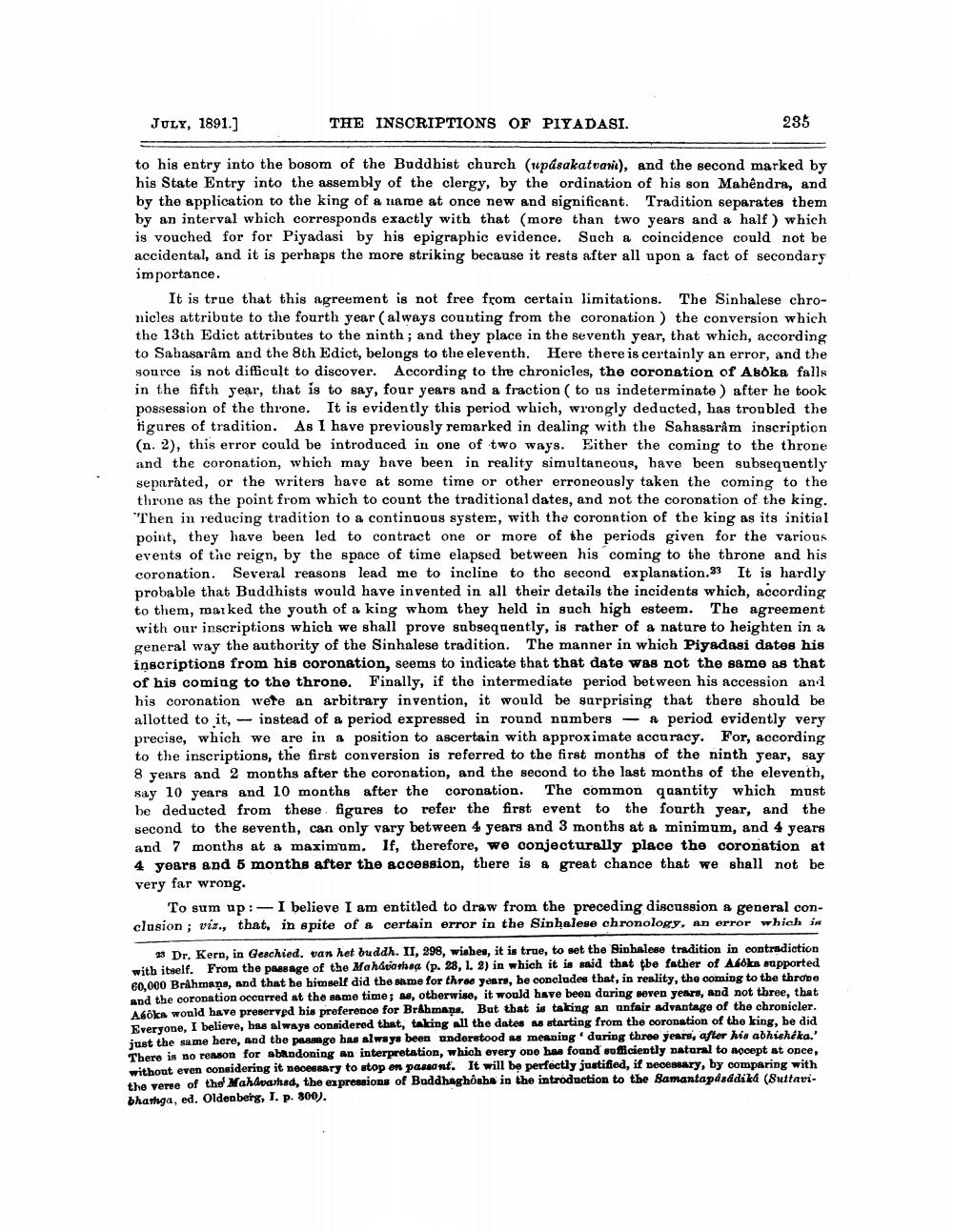________________
JULY, 1891.]
THE INSCRIPTIONS OF PIYADASI.
235
to his entry into the bosom of the Buddhist church (upásakatvani), and the second marked by his State Entry into the assembly of the clergy, by the ordination of his son Mahendra, and by the application to the king of a name at once new and significant. Tradition separates them by an interval which corresponds exactly with that (more than two years and a half) which is vouched for for Piyadasi by his epigraphic evidence. Such a coincidence could not be accidental, and it is perhaps the more striking because it rests after all upon a fact of secondary importance.
It is true that this agreement is not free from certain limitations. The Sinhalese chronicles attribute to the fourth year ( always couuting from the coronation ) the conversion which the 13th Edict attributes to the ninth; and they place in the seventh year, that which, according to Sahasaram and the 8th Edict, belongs to the eleventh. Here there is certainly an error, and the source is not difficult to discover. According to the chronicles, the coronation of Asoka falls in the fifth year, that is to say, four years and a fraction ( to us indeterminate ) after he took possession of the throne. It is evidently this period which, wrongly deducted, has troubled the figures of tradition. As I have previously remarked in dealing with the Sahasarâm inscription (n. 2), this error could be introduced in one of two ways. Either the coming to the throne and the coronation, which may have been in reality simultaneous, have been subsequently separated, or the writers have at some time or other erroneously taken the coming to the throne as the point from which to count the traditional dates, and not the coronation of the king. "Then in reducing tradition to a continuous system, with the coronation of the king as its initial point, they have been led to contract one or more of the periods given for the various events of the reign, by the space of time elapsed between his coming to the throne and his coronation. Several reasons lead me to incline to the second explanation.33 It is hardly probable that Buddhists would have invented in all their details the incidents which, according to them, marked the youth of a king whom they held in such high esteem. The agreement with our inscriptions which we shall prove subsequently, is rather of a nature to heighten in a general way the authority of the Sinhalese tradition. The manner in which Piyadasi dates his inscriptions from his coronation, seems to indicate that that date was not the same as that of his coming to the throne. Finally, if the intermediate period between his accession and his coronation wete an arbitrary invention, it would be surprising that there should be allotted to it, - instead of a period expressed in round numbers - A period evidently very precise, which we are in a position to ascertain with approximate accuracy. For, according to the inscriptions, the first conversion is referred to the first months of the ninth year, say 8 years and 2 months after the coronation, and the second to the last months of the eleventh, say 10 years and 10 months after the coronation. The common quantity which must be deducted from these figures to refer the first event to the fourth year, and the second to the seventh, can only vary between 4 years and 3 months at a minimum, and 4 years and 7 months at a maximum. If, therefore, we conjecturally place the coronation at 4 years and 5 months after the accession, there is a great chance that we shall not be very far wrong.
To sum up:- I believe I am entitled to draw from the preceding discussion a general conclusion ; vis., that, in spite of a certain error in the Sinhalese chronology, an error which is
23 Dr. Kern, in Geschied. van het buddh. II, 298, wishes, it is true, to set the Sinhalese tradition in contradiction with itself. From the passage of the Mahaviathaa (p. 28, 1. 2) in which it is said that the father of Abbks supported 60.000 Brahmans, and that he himself did the same for three years, be concludes that, in reality, the coming to the throne and the coronation occurred at the same time; as, otherwise, it would have been during seven years, and not three, that Asoka would have preserved his preference for Brahmans. But that is taking an unfair advantage of the chronicler. Everyone, I believe, has always considered that, taking all the dates as starting from the coronation of the king, be did just the same here, and the page has always been understood as meaning' during three years, after his abhisheka.' There is no reason for abandoning an interpretation, which every one has found sufficiently natural to accept at once, without even considering it necessary to stop on passant. It will be perfectly justified, if necessary, by comparing with the verse of the Mahavamad, the expressions of Buddhaghosha in the introduction to the Samantapdaddika (8uttavibhathga, ed. Oldenberg, I. p. 800).




